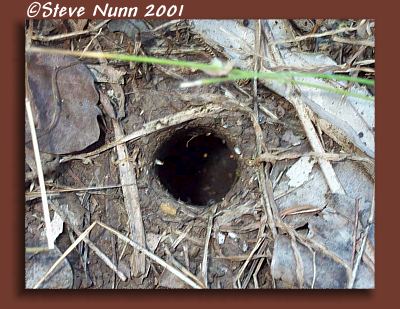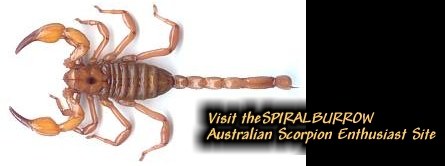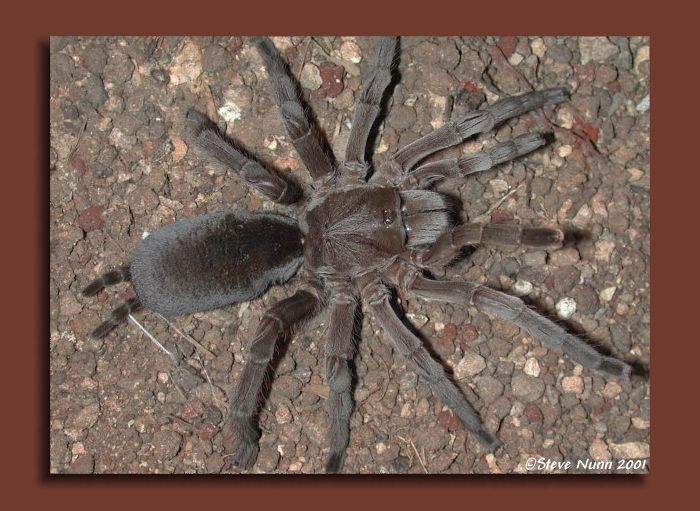

Selenocosmia stirlingi
Selenocosmia stirlingi Hogg (1901) is probably Australia`s most aggressive Theraphosid, striking at anything it perceives as a threat, which is usually anything that moves.
Selenocosmia stirlingi Hogg 1901
Here in Australia we have a really impressive array of tarantulas, some reaching amazing sizes. The spider that really impresses me is Selenocosmia stirlingi.
S. stirlingi can be found on shorefronts around the central Qld coast, all the way to the red center, and through to Western Australia, down to the north western tip of Victoria. As far as tarantula diversity goes, this feat is amazing. I have found them 10m from the shoreline, in riverine rainforest, on mountains and floodplains, through to the desert. This remarkable diversity is achieved because S.stirlingi is an obligate, burrower. The base of the burrow always remains humid and the temperature at the base is stable. They reach quite a size as well, about 145mm (considering that S. stirlingi are a thickset tarantula).
You won’t get a hardier spider than S. stirlingi, these things are tough.
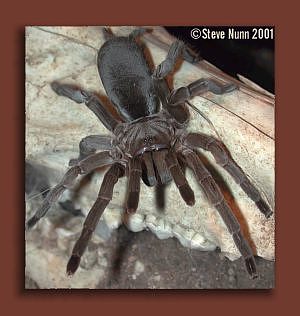 If you live in the colder climates of Australia and wish to collect, give S. stirlingi a go (just give `em lots of substrate).The desired humidity for S.stirlingi is about 70%, 10% lower than it`s rainforest counterparts. In Winter S.stirlingi have been found to seal their burrows off with last years cast skin (exuvium) and crushed prey exoskeleton, all held together with silk. I believe this is done to keep the chamber of the burrow at a stable, survivable temperature whilst above ground can be below zero. Possibly the worlds most diverse tarantula.
If you live in the colder climates of Australia and wish to collect, give S. stirlingi a go (just give `em lots of substrate).The desired humidity for S.stirlingi is about 70%, 10% lower than it`s rainforest counterparts. In Winter S.stirlingi have been found to seal their burrows off with last years cast skin (exuvium) and crushed prey exoskeleton, all held together with silk. I believe this is done to keep the chamber of the burrow at a stable, survivable temperature whilst above ground can be below zero. Possibly the worlds most diverse tarantula.
In 1988 M.Kotzman of the Monash University in Victoria released a research paper based on the sexual differentiation in juveniles of S.stirlingi. This technique doesn`t require dissection of a dead specimen, just examination of the exuvium. It was found that the spermethecae developed from small cuticular buds at the epigastric furrow and were found to be sexually differential at 20-30% of the spiders adult size (regardless of instar count ).
If these buds are above 0.05mm long, then the juvenile can be accurately sexed as a female. Likewise, if the buds are found to be under 0.05mm long, then the juvenile is male.
Kotzmans materials and methods were reasonably complicated and most home enthusiasts won`t be able to replicate his work. The exuviae were dried in 100% EtoH and the chelicerae and anterior third of the ventral abdominal cuticle were mounted in Euparal. Prior to mounting, the abdominal cuticle was stained in Azo black and rinsed in 100% EtoH. His size measurements were created by projecting the mounted exuviae onto a digitiser pad which was connected to a computer. Fangs were measured with dial calipers and the length of the spermethecae were measured with an eyepeice graticule in a dissecting microscope.
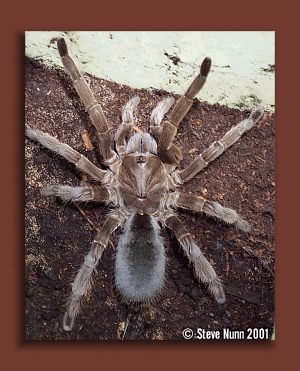 For this determination to be accurate, the single fang measurement of the specimen must be larger than 1.60mm. Kotzman also noticed a distinct dense patch of setae on the epigastrum, between the anterior pair of book lungs of males, well before sexual maturity (see future article on sexing all species). On females, the setae on the abdomen are evenly dispersed. Also, during the moult before sexual maturity (penultimate), the male's palpal tarsi assume a pear shape, noticeable on most males of the family Theraphosidae, during this moult.
For this determination to be accurate, the single fang measurement of the specimen must be larger than 1.60mm. Kotzman also noticed a distinct dense patch of setae on the epigastrum, between the anterior pair of book lungs of males, well before sexual maturity (see future article on sexing all species). On females, the setae on the abdomen are evenly dispersed. Also, during the moult before sexual maturity (penultimate), the male's palpal tarsi assume a pear shape, noticeable on most males of the family Theraphosidae, during this moult.